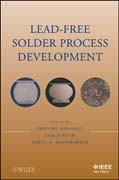
Lead-free solder process development
Henshall, Greg
Bath, Jasbir
Handwerker, Carol A.
INDICE: Technical Reviewers. Preface. Contributors. Introduction. 1. Regulatory and Voluntary Drivers for Environmental Improvement: Hazardous Substances, Lifecycle Design and End of Life (John Hawley). 1.1 Introduction. 1.2 Substances of Environmental Concern. 1.3 Design for Environment/Energy Efficiency. 1.4 Recycling and Take-back. 1.5 Summary. 1.6 References. 2. Lead-free Surface Mount Technology (Jasbir Bath, Jennifer Nguyen and Sundar Sethuraman). 2.1 Introduction. 2.2 No-clean and Water-soluble Lead-free Pastes. 2.3 Solder Paste Handling. 2.4 Board and Stencil Design. 2.5 Screen Printing and Printability ofLead-free Solder Pastes. 2.6 Paste inspection. 2.7 Component Placement (PasteTackiness). 2.8 Reflow Soldering and the Reflow Profile. 2.9 Effect of Nitrogen versus Air Atmosphere during Lead-free Reflow. 2.10 Head-in-Pillow Component Soldering Defect. 2.11 Solder Joint Visual Inspection. 2.12 AOI (Automated Optical Inspection). 2.13 X-ray Inspection. 2.14 ICT/Functional Testing. 2.15 Conclusions. 2.16 Future Work. 2.17 Acknowledgements. 2.18 References. 3. Lead-free Wave Soldering (Dennis Barbini and Jasbir Bath). 3.0 Introduction. 3.1 Wave soldering process boundaries. 3.2 Soldering temperatures on the chip and main soldering waves. 3.3 Alloys for Lead-free Wave Soldering. 3.4 The function of nitrogen in wave soldering. 3.5 The effect of PCB Design on wave solder joint formation. 3.6 Standards related to wave soldering. 3.7 Conclusions. 3.8 Future work. 3.9 Acknowledgements. 3.10 References. 4. Lead-free Rework (Alan Donaldson). 4.1 Introduction. 4.2 Surface Mount Technology (SMT) Hand Soldering/Touch-up. 4.3 BGA/CSP Rework. 4.4 BGA Socket Rework. 4.5 X-ray. 4.6 Through-hole Hand Soldering Rework. 4.7 Through-hole Mini-pot/Solder Fountain Rework. 4.8 Best Practices and Rework Equipment Calibrations. 4.9 Conclusions. 4.10 Future Work. 4.11 References. 5 Lead-Free Alloys for BGA/CSP Components (Gregory A. Henshall). 5.1 Introduction. 5.2 Overview of New Lead-Free Alloys. 5.3 Benefits of New Alloys for BGAs and CSPs. 5.4 Technical Concerns. 5.5 Management ofNew Alloys. 5.6 Future Work. 5.7 Summary and Conclusions. 5.8 Acknowledgements. 5.9 References. 6 Growth Mechanisms and Mitigation Strategies of Tin Whisker Growth (Peng Su). 6.1 Introduction. 6.2 Role of stress in whisker growth. 6.3 Understanding standard acceleration tests. 6.4 Plating process optimization and other mitigation strategies. 6.5 Whisker growth on board-mounted components. 6.6 Summary. 6.7 References. 7. Testability of Lead-Free Printed Circuit Assemblies (Rosa D.Reinosa and Aileen M. Allen). 7.1 Introduction. 7.2 Contact Repeatability of Lead-Free Boards. 7.3 Probe Wear and Contamination. 7.4 Board Flexure. 7.5 Conclusions. 7.6 Acknowledgments. 7.7 References. 8. Board-Level Solder Joint Reliability of High Performan
- ISBN: 978-0-470-41074-5
- Editorial: John Wiley & Sons
- Encuadernacion: Cartoné
- Páginas: 284
- Fecha Publicación: 14/01/2011
- Nº Volúmenes: 1
- Idioma: Inglés
